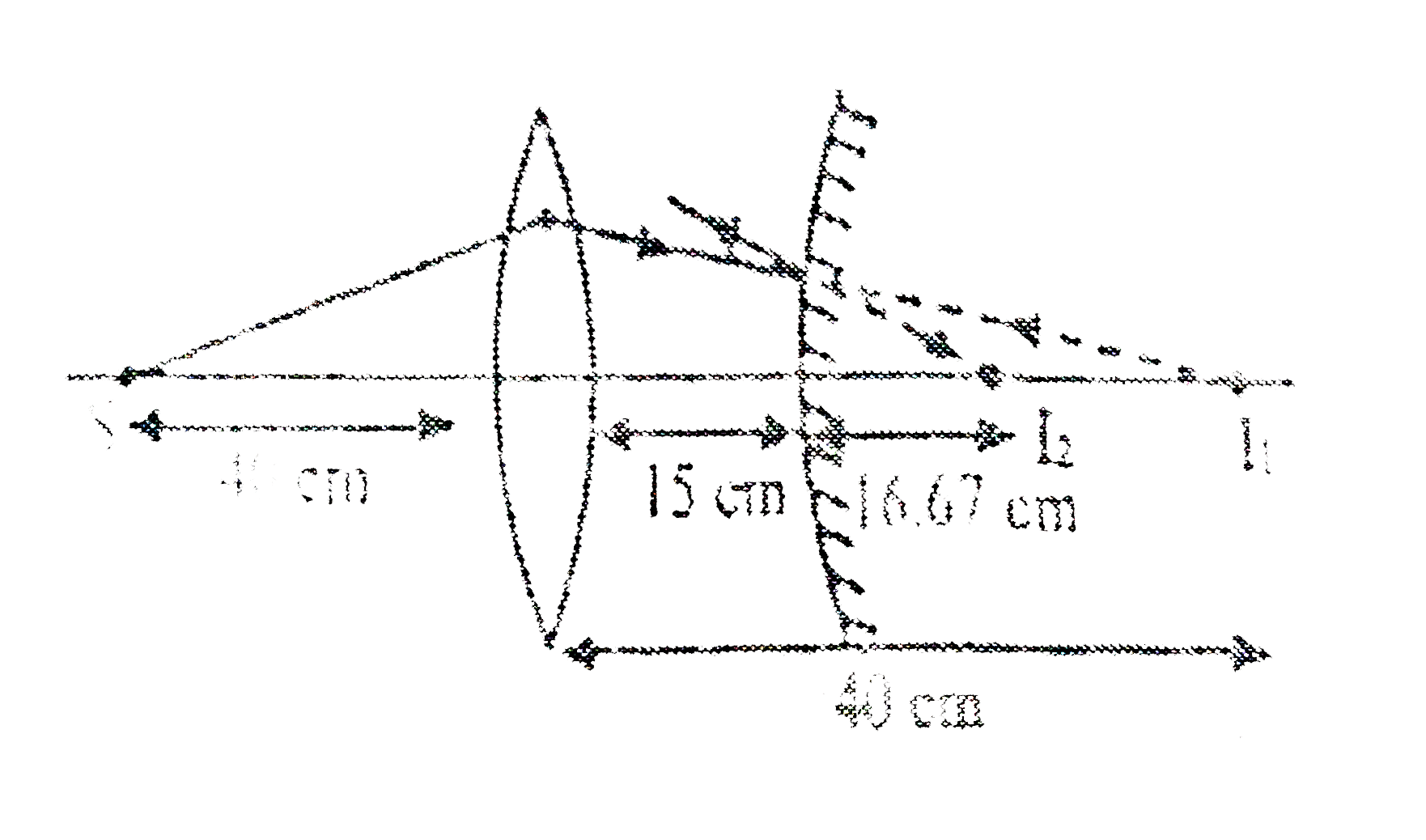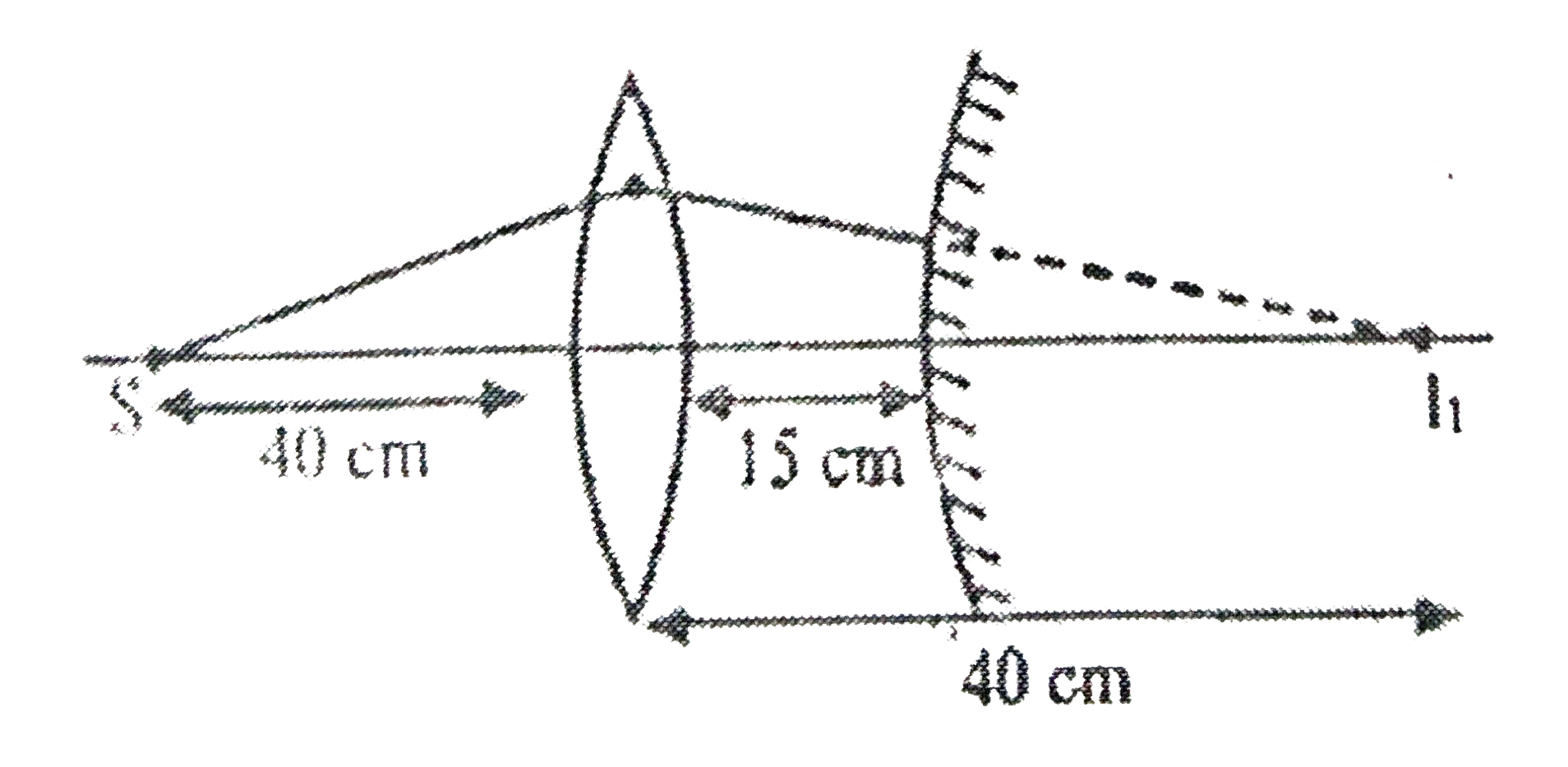A convex lens of focal length 20cm is placed coaxilly with a convex mirror of radius of curvature 20 cm. The two are kept 15 cm apart. A point object is placed 40 cm in front of the convex lens. Find the position of the image formed by this combination. Draw the ray diagram showing the image formation.
Let us first locate the image of the point obect S formed by the convex lens.
Here:
u=−40cm,and,f=20cm
From the lens formula, we have:
1v−1u=1f⇒1v=1u+1f
120+1−40=v=40cm

The positive sign shows that the image is formed to the right of the lens as shown in the following figure.
The image I1 is formed behind the mirror and hence acts as a virtual source for the mirror. The convex mirror forms the image L2, whose distance form the mirror can be calcualted as :
1v+1u=1f
Hence : u=25cmand,f=R/2=10cm
1v=1f−1u⇒1v=110−125

Hence, the final image is formed at a distance of 16.67 cm from the convex mirror as shown in the following figyure.
Topper's Solved these Questions
- XII BOARDSBOOK - XII BOARDS PREVIOUS YEARCHAPTER - XII BOARDSEXERCISE - SET-III DELHI BOARD
11 Videos
- XII BOARDSBOOK - XII BOARDS PREVIOUS YEARCHAPTER - XII BOARDSEXERCISE - SET -I
34 Videos
- XII BOARDSBOOK - XII BOARDS PREVIOUS YEARCHAPTER - XII BOARDSEXERCISE - SET-II
35 Videos
- SAMPLE PAPER 2019BOOK - XII BOARDS PREVIOUS YEARCHAPTER - SAMPLE PAPER 2019EXERCISE - SECTION D
6 Videos
Similar Questions
A convex lens of focal length 20cm is placed co-axially with a convex mirrir of radius of curvature 20cm. The two are kept 15cm apart from eachother. A point object is placed 60cm in front of the convex lens. Find the position of the image formed by the combination.
View SolutionA convex lens of focal length 10 cm is placed coaxially 5 cm away from a concave lens of focal length 10 cm. If an object is placed 30 cm in front of the convex lens, find the position of the final image formed by the combined system.
View Solution
Knowledge Check
An object placed 10 cm in front of a convex lens of focal
length 15 cm. The image produced will beAa Real and magnifiedBb Virtual and magnifiedCc Virtual and reduced in sizeDd Real and reduced in size
A convex lens of focal length 10 cm is placed coaxially 5 cm away from a concave lens of focal length 10 cm. If an object is placed 30 cm in front of the convex lens, find the position of the final image formed by the combined system.
View SolutionA convex lens of focal length 20cm is placed 10cm in front of a convex mirror or radius of curvature 15cm. Where should a point object be placed in front of the lens so that it images on to itself?
View SolutionA convex lens of focal length 10cm is placed co-axially 5cm away from a concave lens of focal length 10cm. If an object is placed 30cm in front of the convex lens, find the position of final image formed by the combined system.
View SolutionA convex lens of focal length 15cm, and a concave mirror of radius of curvature 20cm are placed co-axially 10cm apart. An object is placed in front of convex lens so that there is no parallax between the object and its image formed by the combination. Find the position of the object.
View SolutionA convex lens, of focal length 25 cm, and a concave mirror, of radius of curvature 20 cm. are placed co-axially 4 cm aprat from each other. An incident beam, parallel to the principal axis, is incident on the convex lens. Find the position and nature of the image formed by this combination.
View Solution(a) (i) Draw a labelled ray diagram to show the formation of image in an astronomical telescope for a distant object.
(ii) Write three distinct advantages of a reflecting type telescope over a refracting type telescope.
(b) A convex lens of focal length 10 cm is placed coaxially 5 cm away from a concave lens of focal length 10 cm. If an object is placed 30 cm in front of the convex lens, find the position of the image formed by the combined system.
View SolutionTwo thin lenses, both of 10 cm focal length- one convex and other concave, are placed 5 cm apart. An object is placed 20 cm in front of the convex lens. Find the nature and position of the final image.
View Solution
